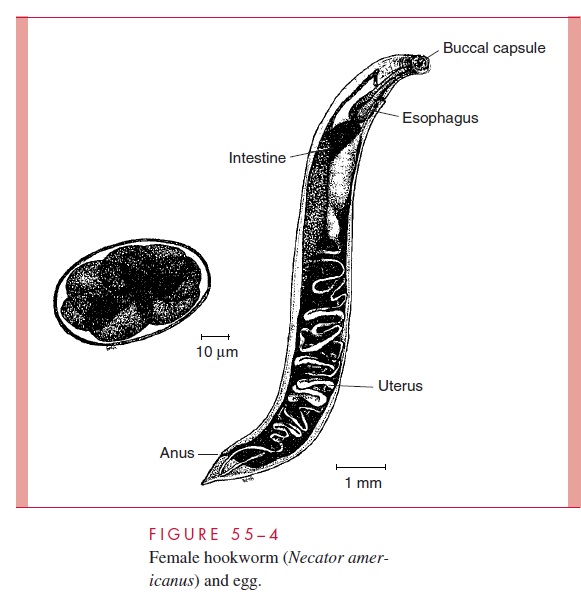Chapter: Medical Microbiology: An Introduction to Infectious Diseases: Intestinal Nematodes
Ancylostoma and Necator :Parasitology - Hookworms
Hookworms
ANCYLOSTOMA AND NECATOR : PARASITOLOGY
Two species, N. americanus and A. duodenale, infect humans. Adults of both species are pinkish-white and measure about 10 mm in length (Fig 55 – 4). The head is often curved in a direction opposite that of the body, giving these worms the hooked appearance from which their common name is derived. The males have a unique fan-shaped copulatory bursa, rather than the curved, pointed tail common to the other intestinal nematodes.

The two species can be readily differentiated by the morphology of their oral cavity. A. duodenale, the Old World hookworm, possesses four sharp toothlike structures, whereasN. americanus, the New World hookworm, has dorsal and ventral cutting plates. With the aid of these structures, the hookworms attach to the mucosa of the small bowel and suck blood. The fertilized female releases 10,000 to 20,000 eggs daily. They measure 40 by 60 μm, possess a thin shell, and are usually in the two- to four-cell stage when passed in the feces (see Fig 55–4).
LIFE CYCLE
For all practical purposes, the life cycles of the two hookworms, N. americanus and A.duodenale, are identical. The eggs are passed in the feces at the 4- to 8-cell stage of de-velopment and, on reaching soil, hatch within 48 hours, releasing rhabditiform larvae. These move actively through the surface layers of soil, feeding on bacteria and debris. Af-ter doubling in size, they molt to become infective filariform larvae, which may survive in moist conditions without feeding, for up to 6 weeks. On contact with human skin, they penetrate the epidermis, reach the lymphohematogenous system, and are passively trans-ported to the right side of the heart and onward to the lungs. Here they rupture into alveo-lar spaces and, like juvenile ascarids, are coughed up, swallowed, and pass into the small intestine, where they mature to adulthood. Larvae of A. duodenale, if swallowed, can sur-vive passage through the stomach and develop into adult worms in the small intestine.
Related Topics